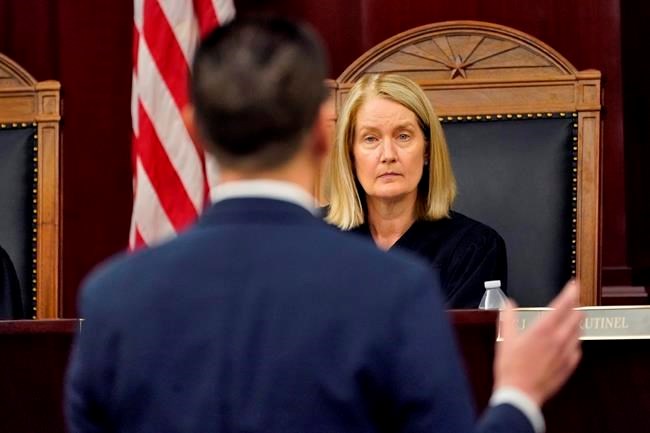PHOENIX (AP) — The Arizona Senate on Monday joined the House in voting to waive a constitutional cap on K-12 school spending that threatened to shut down public campuses across the state.
Monday's 23-6 Senate vote the needed two-thirds majority in both chambers and goes into effect immediately. The vote came after some majority Republicans who had withheld their support signed onto the measure. All six no votes were from GOP lawmakers. It does not need to be signed by Republican Gov. Doug Ducey.
Republican Senate President Karen Fann spent the past week wrangling the votes from members of her caucus. Some Republicans still voted against the measure that allows schools to spend money lawmakers already appropriated for the current budget year.
“There’s one thing we can all agree on regardless of which side of the aisle we are,” she said. “We love our kids, and our kids come first. We just need to figure out how to make that work for all the adults.”
Republican Sen. Vince Leach of Tucson was one GOP member who opposed the measure, railing against public school supporters giving his party no credit for the big boost in school funding they have received in recent years and school boards requiring students to wear masks to limit COVID-19 exposure.
He pushed to provide school vouchers to all students in the state.
“My parents, my constituents, want to fund kids, not buildings, not institutions," Leach said. "They want to fund kids to make sure that they have a good education.”
Leach noted the 20% raise teachers were awarded between 2018 and 2020, noting it was a Republican proposal.
But Democratic Minority Leader Sen. Rebecca Rios pushed back on that narrative, noting that GOP lawmakers and Ducey had offered just a 2% raise in 2018 and did not willingly offer their “20 by 2020 plan.” Instead, it was the result of a statewide teacher strike that closed schools and flooded the Capitol with teachers demanding livable wages.
“I feel compelled to correct the record — 20 by 2020 was not the brainchild of public-school-supporting Republicans," Rios said. “20 by 2020 occurred because of the dissension of 70,000 red T-shirted parents and teachers and allies that came and fought for public education funding.”
Democrats called the delay in passing the spending cap waive a manufactured crisis that put unneeded pressure on teachers and parents who are already stressed after two years of coronavirus restrictions.
Another Republican opponent of the increase lashed out at local schools boards.
“So here we are, feeding the beast, more money, more money, in my opinion capitulating to the educational terrorists who have held our kids hostage,” Sen. Michelle Ugenti-Rita said, blaming local schools for their COVID restrictions.
The House voted 45-14 last Tuesday to give schools the ability to spend $1.154 billion appropriated last year that would have put them over the constitutional spending limit. All 28 Democrats present voted for the waiver, but 14 of 31 Republican House members voted no.
Schools would have exceeded the spending limit on March 1 and would have had to quickly plan for cutbacks that could have included closures or layoffs if the Legislature had not acted. About 880,000 students would have been affected. does not affect public charter schools, which educate about 240,000 K-12 students.
Republicans have been leery of approving the waiver of the aggregate spending limit for fears it could breathe life into Proposition 208, the 2020 voter-approved tax on the wealthy that the state Supreme Court ruled in August was unconstitutional if it put spending over the cap.
A trial court judge is considering whether that would be the case, but has delayed issuing what opponents of the tax say is a certain ruling that the new revenue would exceed the cap. House Speaker Rusty Bowers and Fann recently asked the Supreme Court to step in and kill Proposition 208 for good. The court has not yet acted on that request.
The school spending cap was enacted in 1980 as part of a wave of proposed laws the Legislature asked voters to approve to limit taxes and government spending. It is adjusted each year to take into account inflation and the number of students who are enrolled.
That enrollment figure is based on the previous years' attendance, and last year enrollment dipped precipitously as parents pulled their kids out of school because of COVID-19. A special sales tax dedicated to schools is also being counted under the cap for the first time because the Legislature extended voter-approved Proposition 301 but for the first time allowed its spending to be counted.
Fann said the 1980 law needs to be reexamined, and she wants it done this year.
“When this was set in 1980 we didn’t have Chrome tablets or whiteboards or any of the stuff that we have now that teaches our kids,” Fann said. “Back then in '80 we had schoolbooks and chalkboards and all kinds of things that didn’t cost near as much.”
___
This story has been corrected to show the Legislature allowed school to spend $1.154 billion, not $1.54 billion.
Bob Christie, The Associated Press


